Planning your own trip? Prepare for your trip
Use Rough Guides' trusted partners for great rates
Travel advice for Namibia
From travel safety to visa requirements, discover the best tips for visiting Namibia
Plan and book your private, tailor-made tour with vetted local experts
Namibia’s coastline doesn’t get as much attention as places like Kenya or South Africa, but it’s one of the most unusual stretches of beach you’ll come across. Water temperatures stay between 57–64°F (14–18°C), and the appeal lies more in the landscape than swimming. This is where you’ll find dunes crashing into the ocean, early morning fog, shipwrecks, and seal colonies. Towns like Swakopmund and Lüderitz are easier to access, while northern stretches like the Skeleton Coast require more planning. Here’s our guide to the best beaches in Namibia.
Swakopmund Beach sits where the Namib Desert runs right into the Atlantic—gold dunes on one side, cold surf on the other. The town is known as Namibia’s go-to place for adventure, and the beach is part of that draw.
It’s a popular place to go quad biking through the dunes, sandboarding, and even horseback riding along the shoreline. The ocean is cold—usually around 57–61°F (14–16°C)—but that’s actually a relief if you’ve been sweating through the inland heat.
It’s a great beach for walking, with long stretches of sand that are easy to explore. You’ll find a few beachfront restaurants nearby—The Tug is a popular one if you want seafood with a view.
Swakopmund is about 219 miles (352 km) west of Windhoek. Most people drive—it takes about 4–5 hours on good roads. There’s also the option of a shared minibus for around $9, though it might be tight on space. If you’re flying, Walvis Bay Airport is the closest, around 45 minutes away, with flights from Windhoek. Once you’re in town, it’s an easy walk from most places to the beach.
May to September usually has the clearest weather, with daytime temps between 68–77°F (20–25°C). Summer (December to March) can start off foggy in the mornings but tends to clear up. August can get windy. The water’s cold all year. See our Namibia travel tips for more advice.
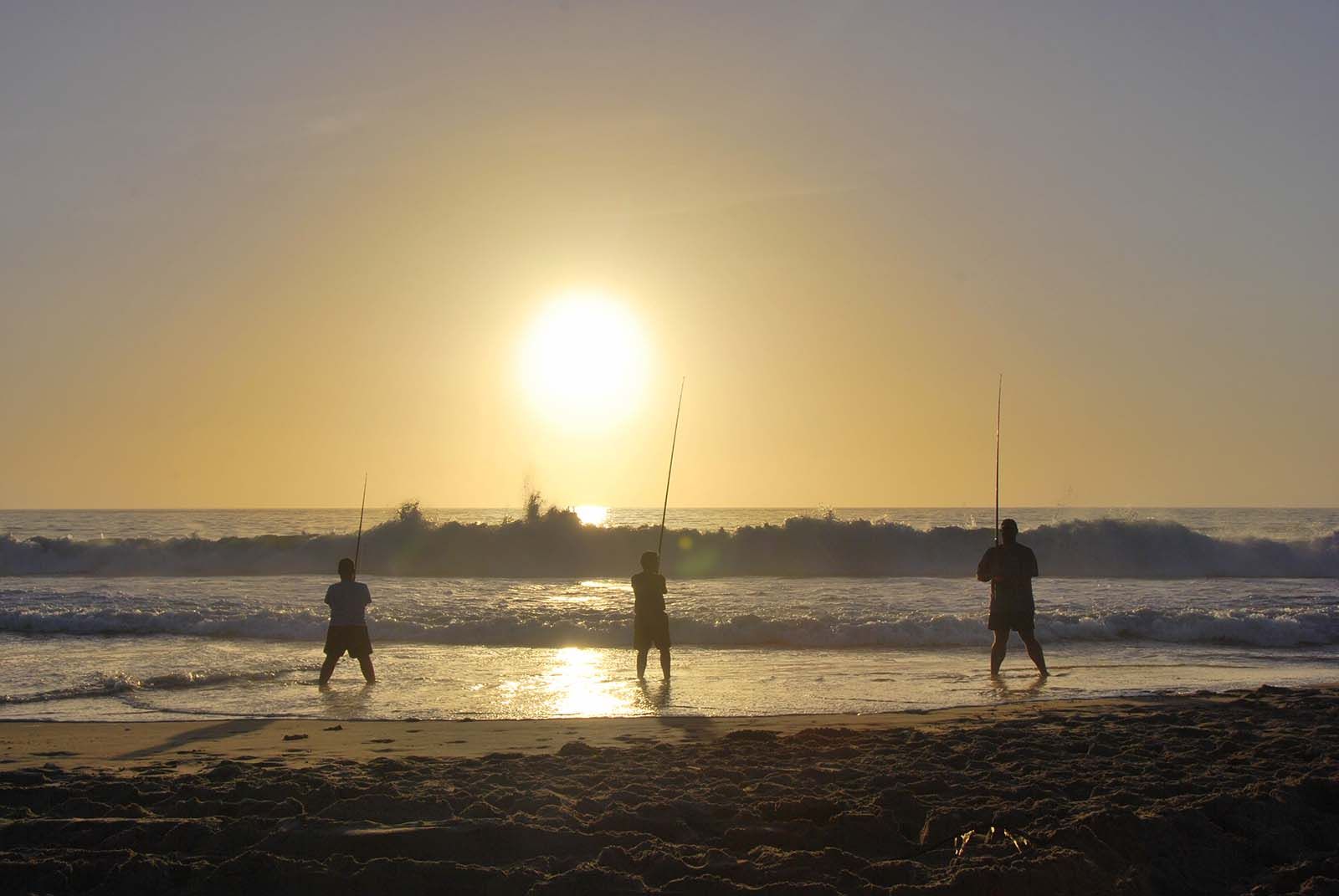
Fishing at Langstrand Namibia © Shutterstock
Langstrand—meaning “long beach” in both Afrikaans and German—is a 9-mile (15-km) strip between Swakopmund and Walvis Bay. It’s wedged between the Atlantic and the massive dunes of the Namib Desert. Surfers like it for the consistent waves, and it’s a good place for a slow walk or a beach picnic.
Even though it’s close to town, Langstrand feels quieter. Most of the places to stay are right on the beachfront, and you’ll find everything from hotels to vacation rentals. It’s pet-friendly and is a good choice if you’re after a beach escape that’s still close to Swakopmund, especially if you want a slower pace or are planning to spend time exploring the dunes.
It’s a straight shot down the C34 from either Swakopmund or Walvis Bay—just about 9 miles (15 km) from each. You’ll see signs for Langstrand or Long Beach. If you’re flying into Walvis Bay, it’s about a 20-minute drive. You can take a taxi from town, but having your own car is better if you want to check out more of the area.
October to April is your best bet—daytime highs are usually between 68–77°F (20–25°C). The ocean stays cold, so not many people go in the water, but it’s great for beach walks and dune hikes. If you’re interested in birdwatching, the nearby lagoons are a good place to see migratory birds like flamingos from November to April.

Namibia skeleton coast © Shutterstock
Cape Cross Beach is mostly known for the Cape fur seals—sometimes more than 200,000 of them during breeding season. It’s loud, smelly, and completely fascinating. You’ll see the seals packed onto the shore, barking and flopping around, especially if you go between late October and December.
Beyond the wildlife, this is also where Portuguese explorer Diogo Cão landed back in 1486. There’s a replica of the stone cross he placed here, and some basic info displays if you want a bit of history with your visit. The shoreline is rugged and remote—classic Skeleton Coast.
There’s a walkway so you can get pretty close to the seals without disturbing them. There are also toilets and picnic tables nearby. Swimming isn’t safe here, but it’s a great place to see wildlife and get a sense of Namibia’s rough coastal landscape. Just be ready for the strong smell that comes with thousands of seals.
Getting around Namibia can be a bit of an adventure. It’s about 75 miles (120 km) north of Swakopmund—roughly a 1.5-hour drive along the C34. The road is a well-kept salt road, but there’s no public transport, so you’ll need a private vehicle. You can either rent a car or book a guided day trip from Swakopmund. The entrance to the seal reserve is marked, and there’s a short road that leads to the parking area.
Late October to December is when you’ll see the most seal activity, especially in November when most of the pups are born. The reserve opens at 10 am, and if you stay until closing (5 pm), you can catch a pretty good sunset over the ocean.
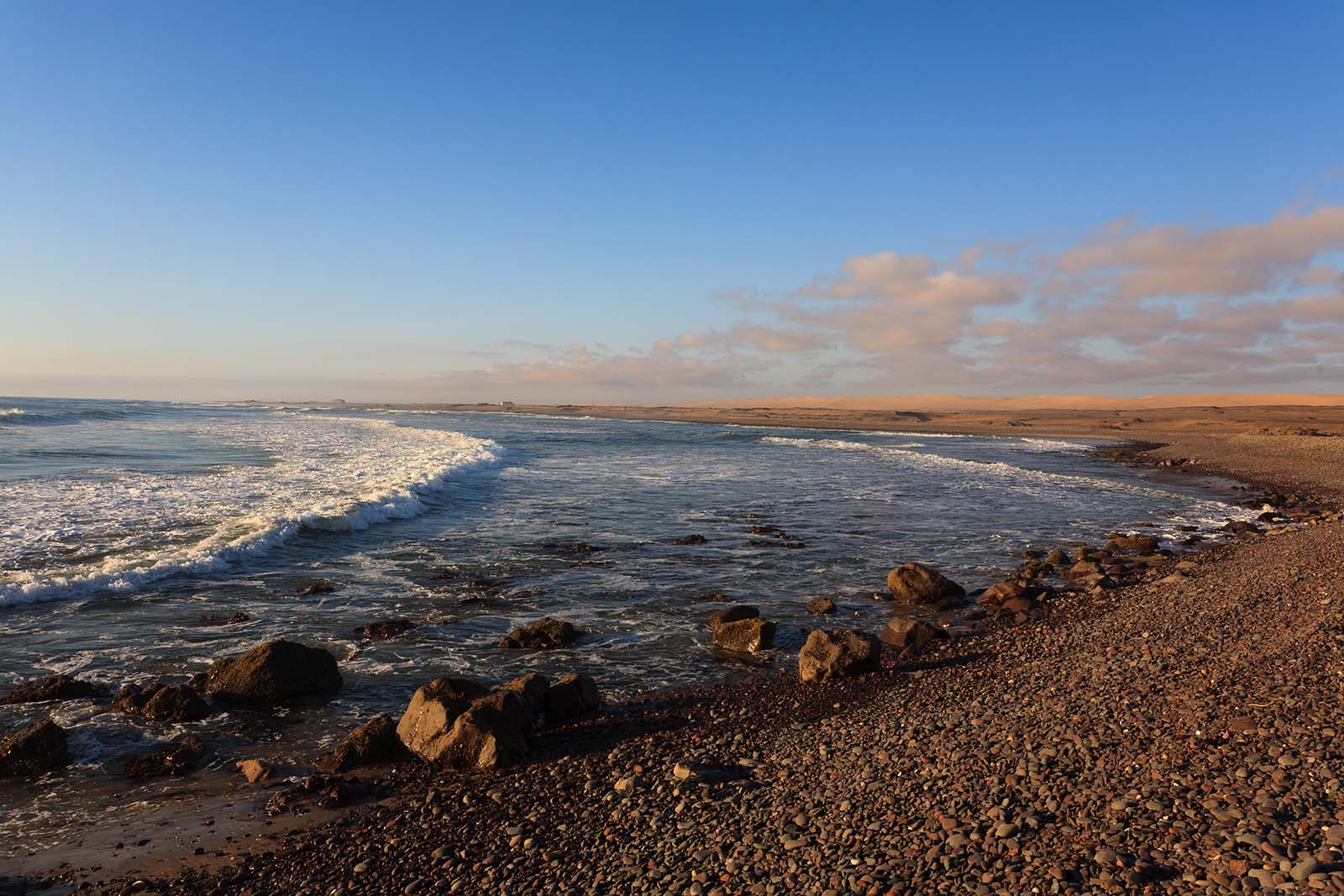
Beach of Terrace Bay, Skeleton Coast, Namibia © Shutterstock
Terrace Bay Beach sits at the far northern edge of Skeleton Coast Park, in one of the most remote parts of Namibia’s coastline. The area is all wind, sand, rock, and crashing surf—the kind of place where you really feel the elements. Old shipwrecks are scattered along the shoreline, a reminder of how tough the Atlantic can be here. This is one of the best things to do in Namibia.
There’s not much in the way of infrastructure, just the basics at Terrace Bay Resort—some simple chalets, a restaurant, a bar, and a shop with essentials. Most people who make the trip are here for the fishing—kabeljou (silver cob) is the main draw. But it’s also a good place for people who want to disconnect completely.
There’s not much noise apart from the wind and waves. The Uniab River Delta is nearby too. If there’s been enough rain, it turns into a kind of desert oasis and draws in wildlife you wouldn’t expect to see this far out.
Getting here takes some effort. It’s about 178 miles (287 km) north of Henties Bay, or around 225 miles (363 km) from Swakopmund. The drive from Swakopmund takes about 6 hours, mostly along gravel or salt roads. A 4x4 is useful, especially if it’s been rainy, but not absolutely required in good conditions. For more safety information, see our Namibia travel health tips.
You’ll need to go through one of the park’s gates—Ugab or Springbokwasser—and get a permit. The gates have strict hours, so don’t cut it too close or you might not get in.
May through September is usually the best stretch for travel—dry weather and cooler temps make things easier. If you’re fishing, November to April is when kabeljou are more active. February through April can be interesting too, especially if the Uniab River is flowing and drawing in animals. There aren’t many rooms at the resort, so it’s worth booking half a year—or more—in advance.
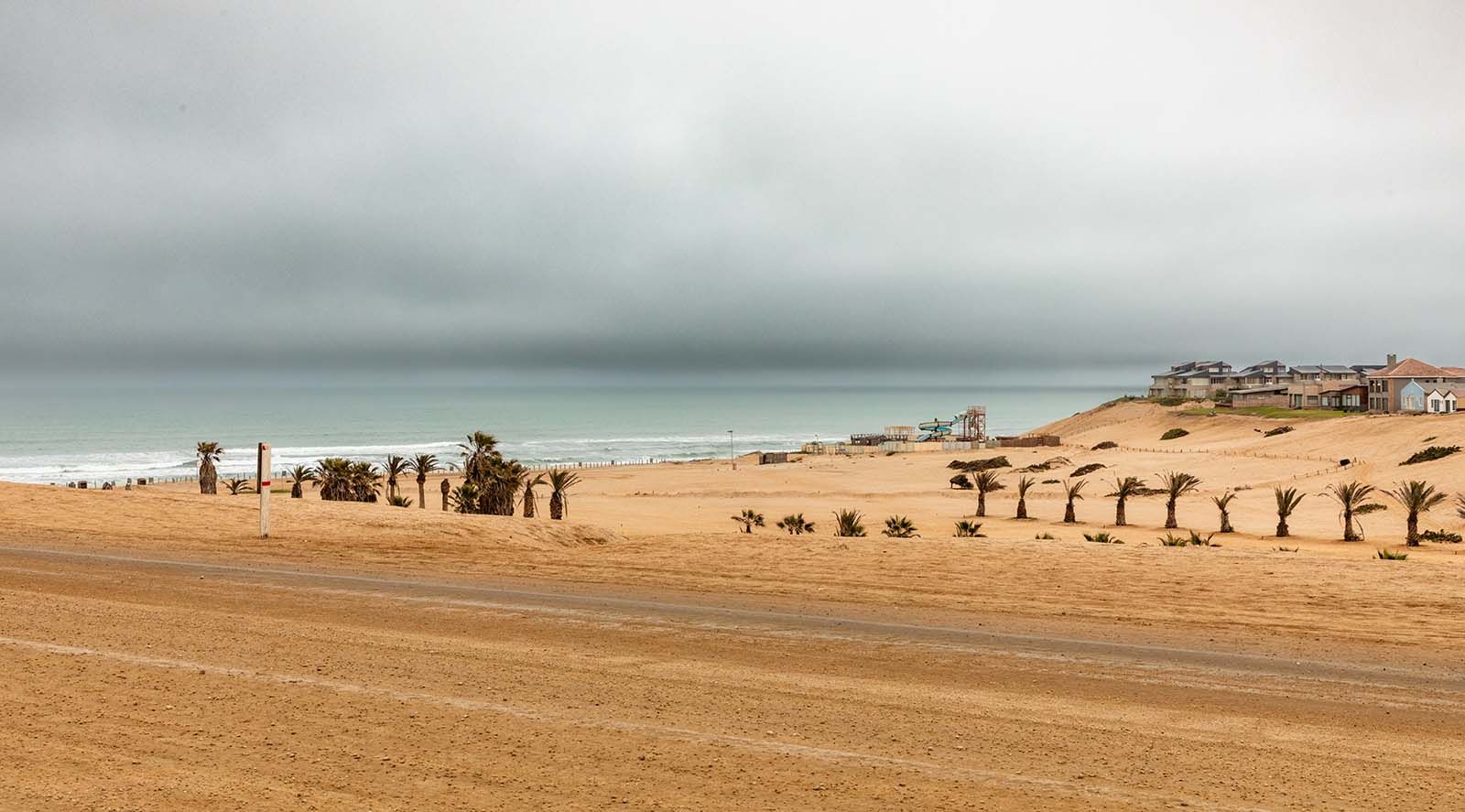
Part of the town of Henties Bay on the Skeleton Coast shoreline of Namibia © Shutterstock
Henties Bay is the best beach in Namibia for fishing. It’s a long stretch of beach known for calm mornings, wide-open space, and that misty Skeleton Coast feel. Besides the fishing, it’s a good place for beach driving, watching sunsets, or just soaking in the fresh Atlantic air.
The town has everything you’ll need for a few days—basic shops, restaurants, and a range of places to stay. Camping is allowed in certain areas, and there are ablution blocks available. You’ll see families, retirees, and anglers all making the most of the relaxed, uncrowded shoreline. There are also a few shipwrecks along the coast to explore, and the marine life here can be surprisingly active.
It’s an easy drive—to get to this Namibia beach just head north from Swakopmund along the C34 for about 43 miles (70 km). The gravel road is generally in good shape, and a regular car is fine when it’s dry.
If you’re coming from Windhoek, it’s about 221 miles (356 km) to Swakopmund on the B2, then just follow the coast up. Be sure to fill your tank before you leave Swakopmund—services get more spread out the further north you go. Once you reach town, beach access is easy to find.
October through April tends to be the most comfortable and also the best for fishing. December and January are warmer and busier, especially around the holidays. July and August can be a bit of a gamble—cold fog can hang around for days. If you’re planning to drive on the beach, check the tide schedule first. High tide can sneak up and make things tricky.
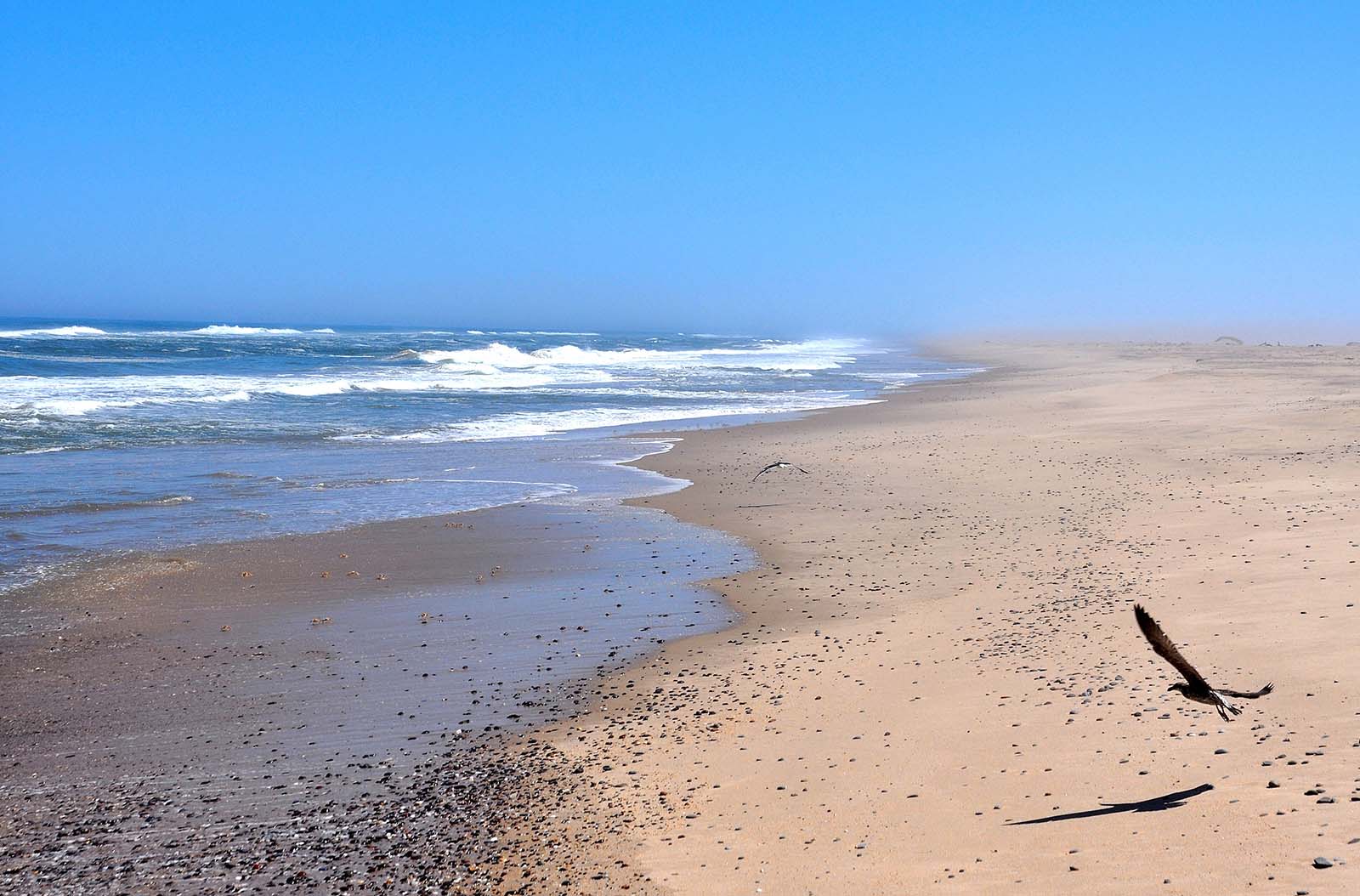
Skeleton coast © Shutterstock
Möwe Bay is about as remote as it gets. It’s deep inside the Skeleton Coast National Park, where towering dunes give way to a wild, wind-blasted shoreline. There’s barely a trace of human development here, which makes it a dream for anyone looking for true isolation. Wildlife is surprisingly abundant—you might spot desert-adapted animals, a seal colony, or birds along the coast. Facilities are almost nonexistent aside from a ranger station, so you’ll need to bring everything with you.
There’s also a strange set of geological formations called the clay castles just inland. They’re weird, almost sculptural, and worth the detour if you’re already nearby.
You’ll need a 4WD and a special permit from the Namibian Wildlife Authorities before you go. The easiest way in is through the Springbokwasser Gate, then follow the park road about 100 miles (160 km) north. Signage is minimal, and phone signal is unreliable, so GPS is important. Be ready for deep isolation—bring spare fuel, extra water, and an emergency plan. There’s no backup out here.
March through May is the most manageable—less fog, milder heat, and more animal activity. The colder months (June–August) bring heavy fog and chilly weather. Summer can be very hot, so you’ll need to plan for extra water. Some parts of the park might be closed at certain times to protect wildlife, so it’s a good idea to call ahead and check.
If there’s been rain inland, flash floods can make parts of the road impassable, so always get an update on conditions before heading out.
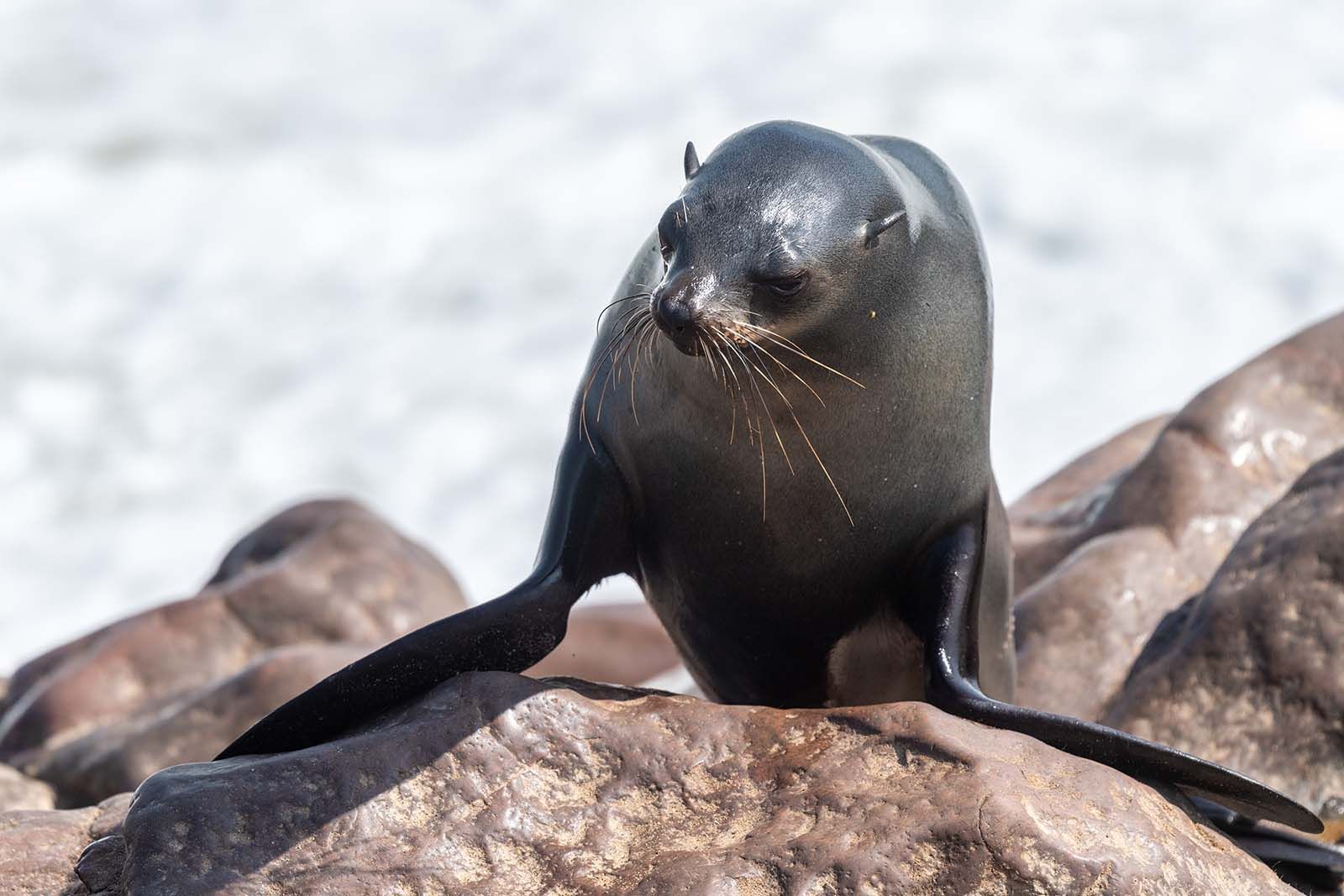
Seal colony in Namibia © Shutterstock
Rocky Point Beach is a great place to take in the wilder side of Namibia’s northern coast. It’s a rugged stretch where volcanic rock meets crashing Atlantic waves. People mostly come here to fish—especially for kabeljou and steenbras, which are both found in these waters.
Getting here takes some effort, and you’ll need a 4x4 to make it through the sand tracks. There are no services or buildings, so you’ll need to bring in everything: water, food, shelter, fuel, and a solid recovery plan. There’s a rawness to this place that appeals to more experienced travelers—those who are comfortable being totally off-grid. The tide pools are worth checking out, and the sunsets framed by the rock formations are lovely.
From Henties Bay, head north 93 miles (150 km) along the salt road to Torra Bay. After that, it’s another 62 miles (100 km) on sand tracks with no clear signage. You’ll need a proper 4WD, recovery gear, and satellite communication.
It’s smart to travel in a group. Permits are required, and you’ll need to get them from the Ministry of Environment and Tourism in Windhoek or Swakopmund. Bring more supplies than you think you’ll need—at least double your intended stay—since you’re really on your own out there.
The best time to go is from mid-November to early April, when the tracks are usually dry enough to be passable. Fishing tends to be better in December and January when the water warms up a bit. Avoid traveling during or right after rain—the tracks can turn into mud pits fast. Coastal thunderstorms can hit in summer, so keep a close eye on weather reports. Help is far away, and the terrain doesn’t forgive mistakes.
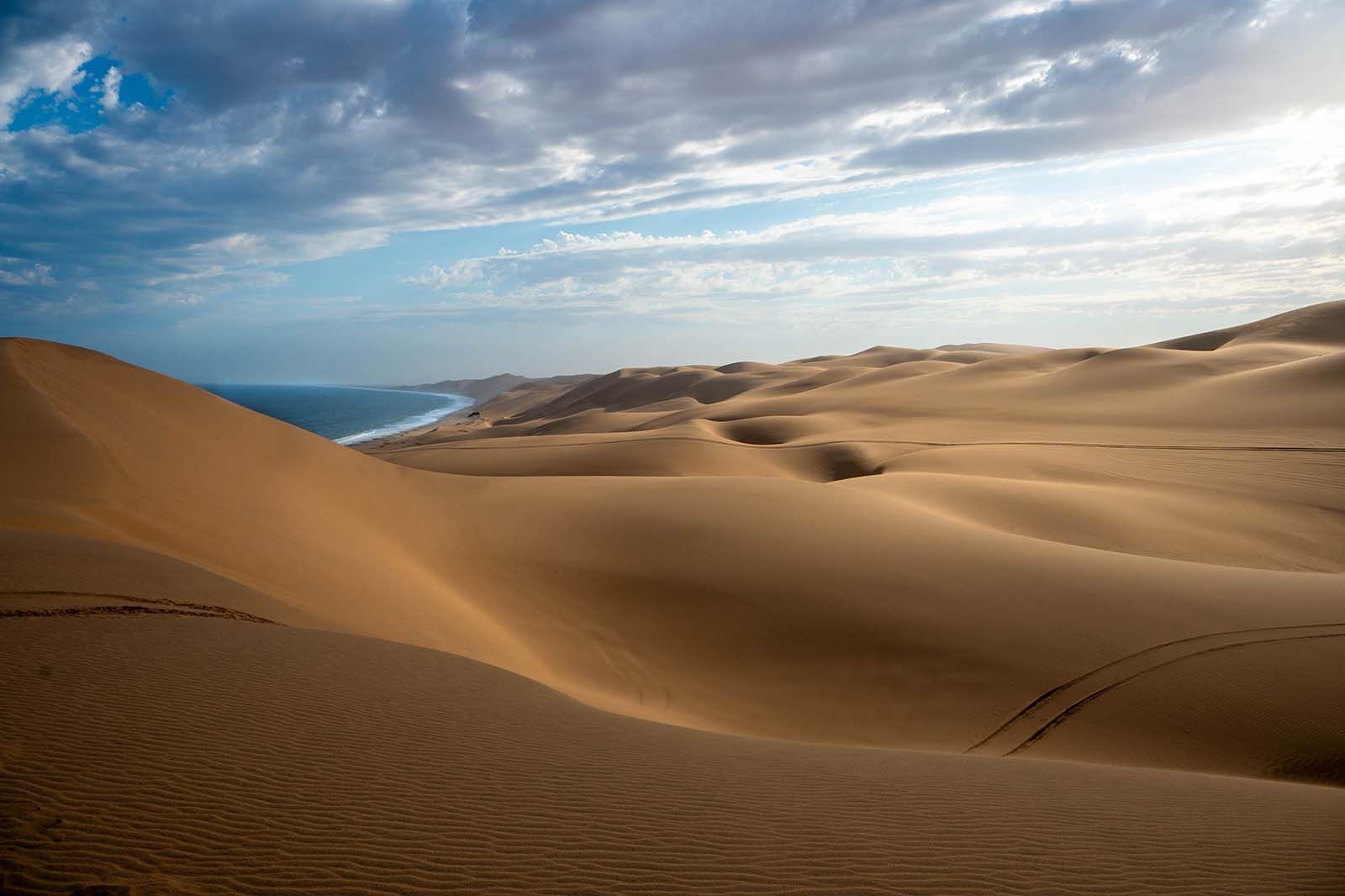
Sand dunes of Sandwich harbour, namibia © Shutterstock
Sandwich Harbour Beach is one of those rare places where sand dunes drop straight into the sea. It's inside Namib-Naukluft National Park and is known for both its dramatic landscape and birdlife. Over 200,000 migratory birds stop here at different times of the year. There are no facilities and no cell service, so it’s really just you and the elements.
It’s a good trip if you're interested in birdwatching or just want to see something that feels untouched. The dunes are always shifting thanks to the wind, so the landscape changes constantly. There’s also a bit of history here—the area used to be a small trading harbor.
You’ll need a 4x4 or to go with a guide. It’s about 34 miles (55 km) south of Walvis Bay. If you’re driving yourself, you’ll need a permit from the Ministry of Environment office in town. The route runs right along the beach, so you’ll need to plan your timing carefully—at high tide the road disappears. It’s easy to get stuck or lost, which is why a lot of people go with a guide who knows how to read the tide and sand.
February through May is the sweet spot if you’re after good weather and light. For birdwatching, the peak season is November to April. Just make sure to check the tide schedule in advance—timing is everything for this trip. Winds pick up in the afternoon, so mornings tend to be easier.

Seals jump by kayak, Walvis Bay, Skeleton Coast , Namibia © Shutterstock
Pelican Point Beach stretches along a long sandbar that shields Walvis Bay. It’s a strange, quiet place—seals everywhere, seabirds flying overhead, and not much else. The seal colony is huge, and they’re not shy. You’ll see them up close, sometimes right next to you if you’re kayaking. Flamingos, pelicans, and cormorants hang around the nearby salt pans, too.
There’s a lighthouse at the point and one remote lodge nearby, but otherwise it’s just sand and sea. It’s a good trip for anyone interested in kayaking in unusual places.
To get there, drive about 6 miles (10 km) along the sand from Walvis Bay with a 4WD. You’ll need to lower your tire pressure before heading out since the sand is soft in sections. The drive is part of the experience—you pass by salt flats with flamingos and even go near Skeleton Bay, which is a famous surf break.
If you’re staying at Pelican Point Lodge, they’ll take care of transport. Otherwise, you can book a tour or go it alone if you’ve got the gear and know-how.
May to September tends to be the most comfortable time, with cooler temperatures and more active wildlife. Morning is best for photography and kayaking—it’s usually calmer before the wind picks up. Expect fog in the afternoons; it rolls in fast and stays. Even if it looks sunny, bring layers.
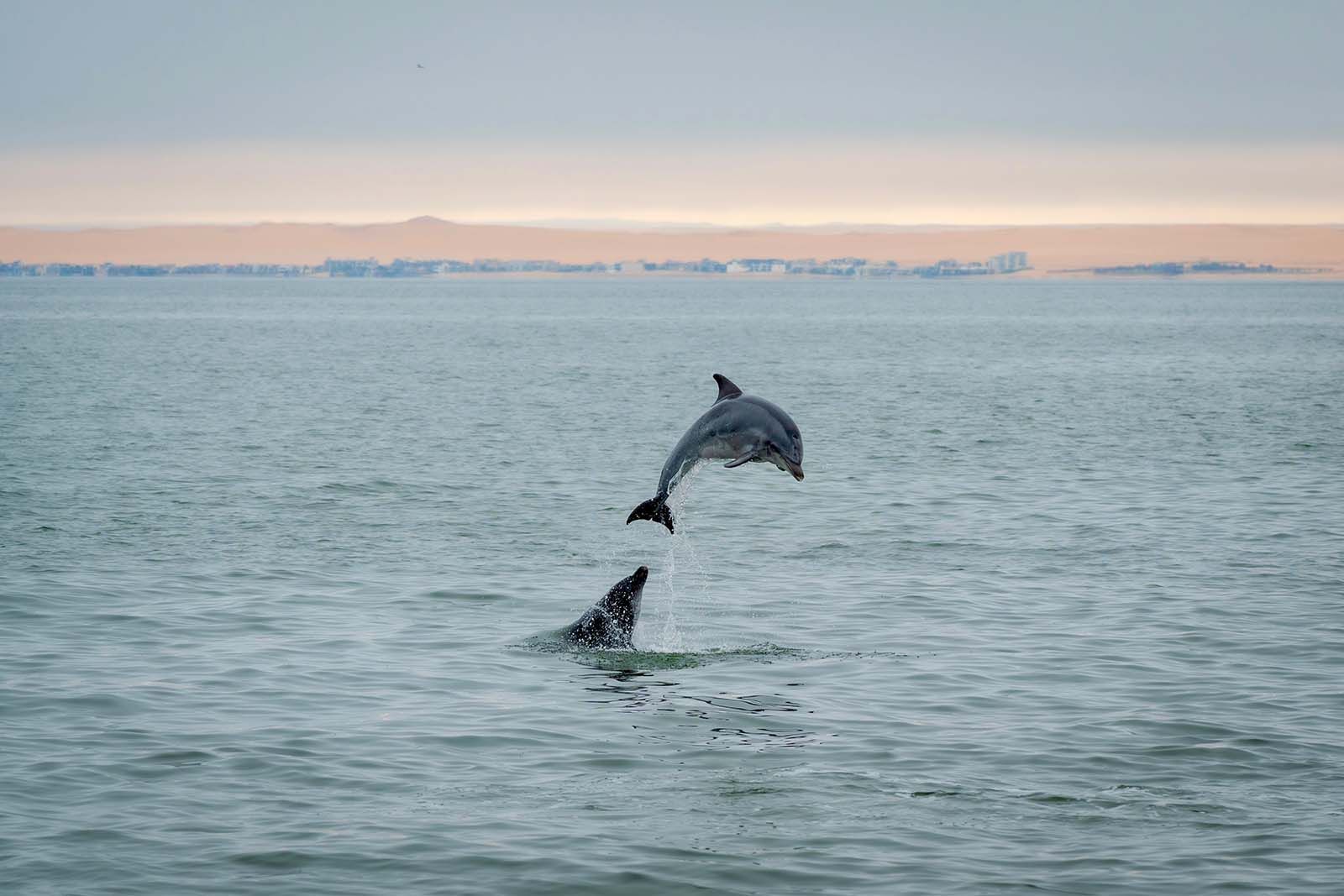
Bottlenosed-dolphin in Walvis Bay, Namibia © Shutterstock
Dolphin Beach, or Dolfynstrand as it’s known locally, is a wide stretch of sand between Walvis Bay and Swakopmund. You’ll often catch sight of dolphins just offshore—especially bottlenose and Heaviside’s dolphins—so keep your eyes on the waves. The beach has plenty of room for walking, casual games, and laid-back picnics with a view of the Atlantic.
Swimming’s not really the main draw here, since the cold Benguela current keeps the water chilly, but surfers do make use of the waves.
There are basic facilities like restrooms and concrete grills near the beach, and you’ll find a mix of Namibia accommodation nearby—from beachfront villas to self-catering places. Since the area was developed as a resort town in the 1970s, it has the feel of a quiet residential neighborhood with easy access to the coast.
Dolphin Beach is about 12 miles (20 km) south of Walvis Bay, right along the B2 road heading toward Swakopmund. It’s an easy 20-minute drive from Walvis Bay or around 25 minutes from Swakopmund. Just follow the signs for Dolfynstrand/Dolphin Beach. There’s convenient parking near the beach, which makes it easy if you’re carrying picnic gear or traveling with kids.
The dry season (April to November) is generally the most pleasant, with mild temperatures and less wind. December through February is warmer but also busier with local holidaygoers. If you’re hoping to see dolphins, early mornings—especially when the sea is calm—are your best bet. No matter the season, pack a warm layer; the breeze coming off the Atlantic can be pretty chilly.

Flamingos of Namibia © Pixabay
Walvis Bay Lagoon Beach sits right next to one of southern Africa’s key wetlands, a massive 110,000-acre (45,000-hectare) stretch that draws flamingos by the thousands. On a good day, you’ll see them wading just offshore in that surreal mix of pink, gold, and blue.
The beach here is quieter and more developed than some others along the coast. A long, flat promenade runs along the lagoon, which makes it a favorite for walkers, joggers, and families.
The shallow water is calm and sheltered, and you’ll find restaurants nearby like The Raft, where you can eat right out over the water. The beach connects easily with the town, so you can go from birdwatching to lunch without needing a car. If you're interested in seeing wildlife, don't miss our guide to the best Namibia safaris.
It’s just a short hop from the center of Walvis Bay—about a 5-minute drive or a 15-minute walk. Look for signs to the Esplanade or Waterfront. There’s parking along the promenade, and the walkways are paved and flat, making them accessible for strollers and wheelchairs. If you’re staying outside town, local taxis can drop you right by the entrance.
Flamingo numbers peak between November and April, when migratory birds swell the resident population. Mornings are best for photography and birdwatching, since the light’s softer and there’s less wind. Sunsets can be spectacular too, with golden reflections across the water. It’s a year-round destination, but keep in mind that June through August can be cold—layer up so you can stay longer.

Lüderitz Namibia Diaz Point © Shutterstock
Diaz Point Beach is where Portuguese explorer Bartolomeu Diaz landed in 1488, and today you’ll still see the stone cross replica marking the site. It’s a rugged, windswept section of coastline, where the sandy beach gives way to jagged rocks and tide pools full of sea life.
There’s plenty of wildlife here—Cape fur seals are a common sight, and birders will appreciate the variety, from flamingos to oystercatchers.
You’ll also find a red-and-white lighthouse nearby that adds a bit of character to the view. Facilities are very limited, but there is a small café called Skip Skop if you want something to eat.
Diaz Point is about 12 miles (20 km) outside Lüderitz. The gravel road runs around the lagoon, and while you don’t need a 4WD in dry conditions, it helps. There are signs pointing to Diaz Point and the lighthouse. The last stretch involves a short walk across some rocks, since the old bridge is no longer usable. Give yourself around 30 minutes to drive there from Lüderitz, and extra time if you want to explore.
Winter (May to September) tends to have lighter winds and better visibility. Mornings are usually clearer, as fog tends to roll in during the afternoon. Wildlife is present year-round, but if you want to see seals during their breeding season, aim for November or December. Weather here can shift quickly—bring layers and prepare for wind, even on sunny days.
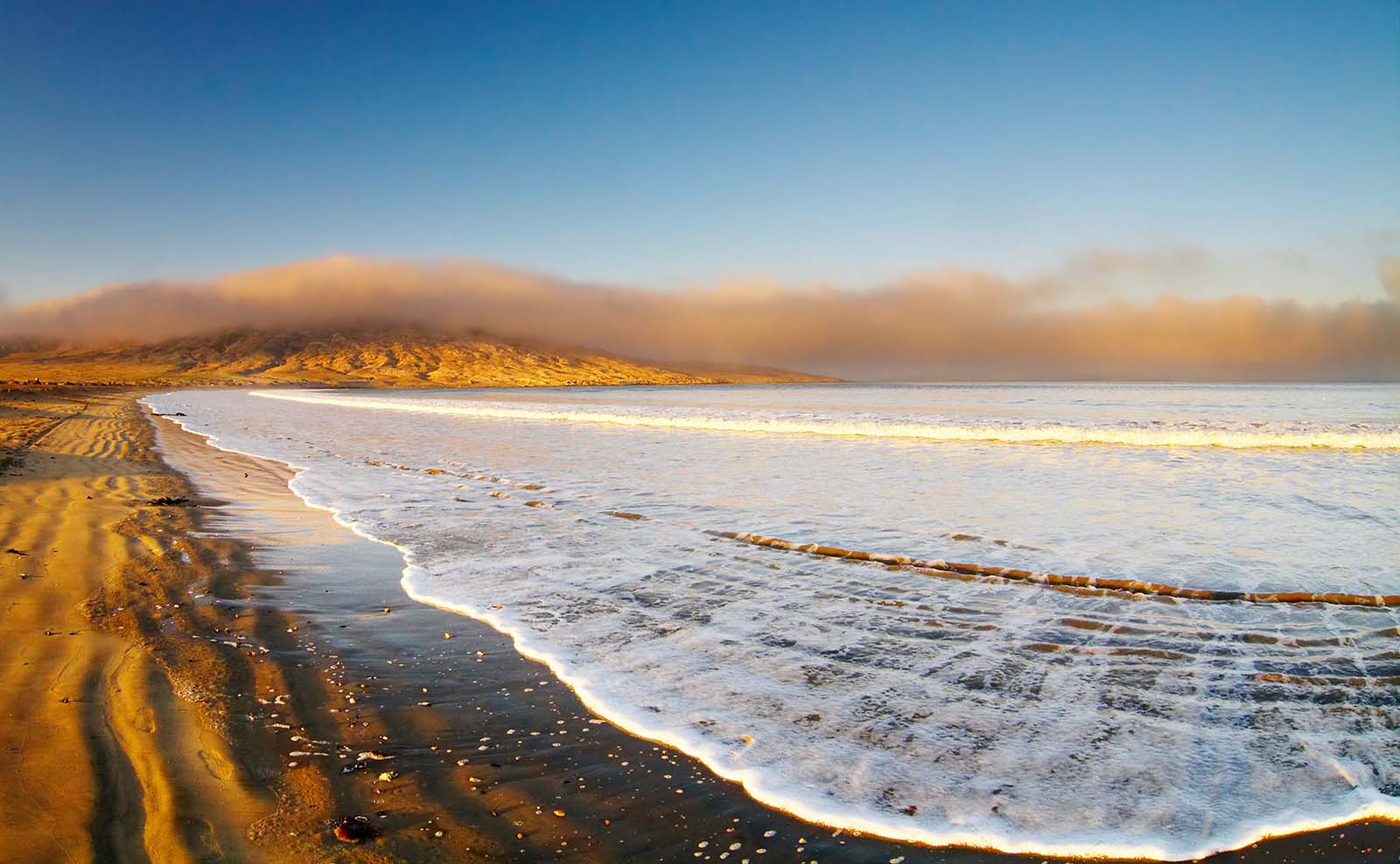
Atlantic coast, Luderitz, Namibia, Agate Beach © Shutterstock
Just outside Lüderitz, Agate Beach is where the desert runs straight into the Atlantic. It’s named for the agates, quartz, and jasper that occasionally wash up along the shore, which makes it a fun stop if you like beachcombing or have an interest in geology. There are picnic tables and built-in braai grills, so it’s a good place for a low-key afternoon out of town.
The ocean’s cold here, so people don’t usually swim, but the setting—dunes meeting waves—is worth seeing. The nearby lagoon often has flamingos, and seabirds are around throughout the day. Facilities are minimal—there are toilets, but they’re not always well-kept—so plan accordingly. It’s not far from town, but it does feel like a break from it.
Head north out of Lüderitz for about 3 miles (5 km) and keep an eye out after the water treatment plant—there’s a small sign pointing you toward the beach. You can make it with a regular car, but if you’re hoping to drive closer to the water, a 4x4 helps. If you’re planning on birdwatching, you might want to stop at the wetland area just after the treatment plant.
Try to go in the morning, between 8 and 11 a.m., before the wind picks up. Lüderitz is known for its gusty afternoons. It’s usually more comfortable in winter (May to August), but even then, pack a windbreaker. The weather can shift quickly. Early mornings are also best for seeing flamingos near the lagoon.
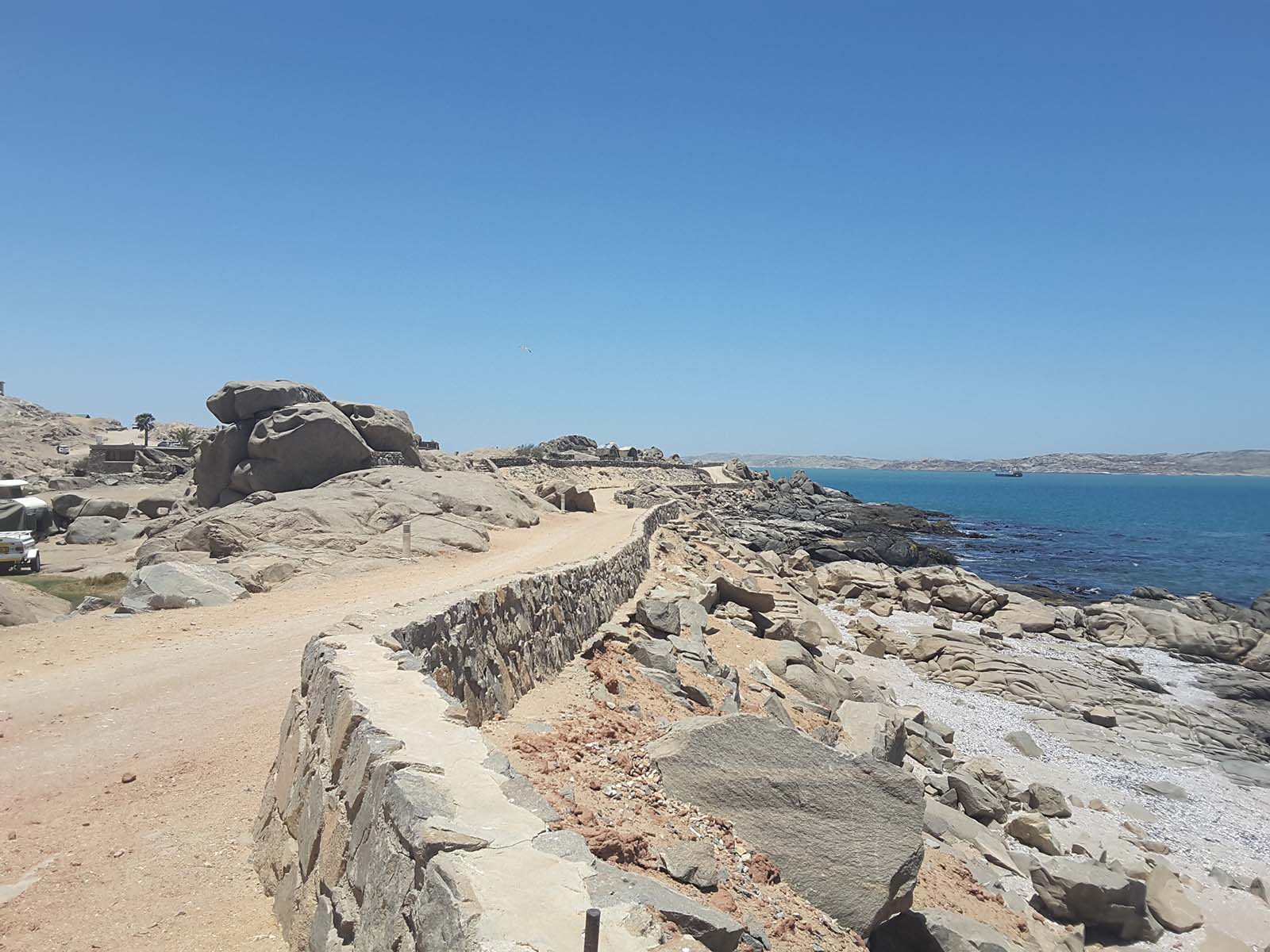
Shark Island Shark Island, Namibia © Shutterstock
Shark Island sits on a rocky peninsula in Lüderitz Bay. It’s not a sandy beach— more rugged shoreline with views in every direction. It used to be an island, but now it’s connected to the mainland. You’ll probably see seals and pelicans hanging out near the rocks, and there’s space to walk around and take in the landscape.
There’s a basic campground run by Namibia Wildlife Resorts, with bathrooms and power hookups. If you're staying overnight, it works. Day-trippers come for the views of the harbor and town, but there’s also a heavy history here. This area was once used as a concentration camp during the colonial period, and you’ll see a few signs explaining that past.
It’s a short drive—about 3 to 4 miles (5 to 6 km) from Lüderitz. Just follow the coastal road south to the peninsula. You’ll need to check in at the small office on Schinz Street when you arrive. The road is paved, so any car will do, though it gets a little busier during the holidays. Day visits are fine without booking, but reserve ahead if you’re planning to camp.
April to October is usually the best window—less rain, milder temperatures. Mornings are good for sunrise views, and evenings are nice for sunset. Because the peninsula is exposed, wind can be strong, so check the forecast. At low tide, you can explore the rocky shoreline. Early mornings are best for seabird activity.

Skeleton Coast in Namibia © gg-foto/Shutterstock
Torra Bay sits inside Skeleton Coast National Park and is only open during December and January. It’s remote and quiet, and mostly draws people who are there to fish. The surf fishing is what brings most people up here, but it’s also a place to just camp and take in the coast without distractions. Whale bones and rusted shipwreck pieces show up along the beach from time to time.
There are 60 campsites with shared bathrooms and a very small shop for basics. You’ll need to bring most of what you need, though the shop and fuel station help in a pinch. This isn’t a beach for lounging—it’s for people who are comfortable being out in the elements and want to spend time in a place that feels untouched.
It’s about 180 miles (290 km) north of Swakopmund on the C34. You’ll need a 4x4—some parts of the road are sandy. You’ll also need a park permit, which you can sort out ahead of time through Namibia Wildlife Resorts. When you arrive, check in at the camp office. Bring enough food, water, and supplies. The closest town is a long way off.
December and January are the only months you can go, and even then, the weather can be unpredictable. Mornings often start with heavy fog. Afternoons might be hot, cold, or windy—it changes quickly. Fishing tends to be better in the early morning and late afternoon, when the tide is turning. Nights get cold, so warm layers are important, even in the middle of summer.
written by
Dre Roelandt
updated 25.06.2025
Dre Roelandt is originally from the United States but lives and works in Berlin, Germany. Dre is a freelance writer and artist with a passion for travelling. They are an in-house Senior Content Editor at Rough Guides.
Use Rough Guides' trusted partners for great rates
From travel safety to visa requirements, discover the best tips for visiting Namibia
Discover Namibia's most captivating stories